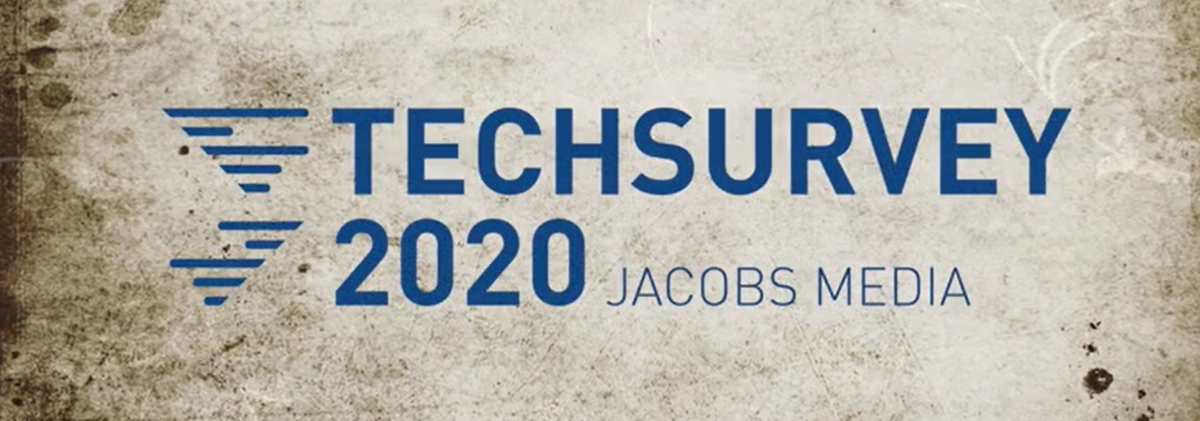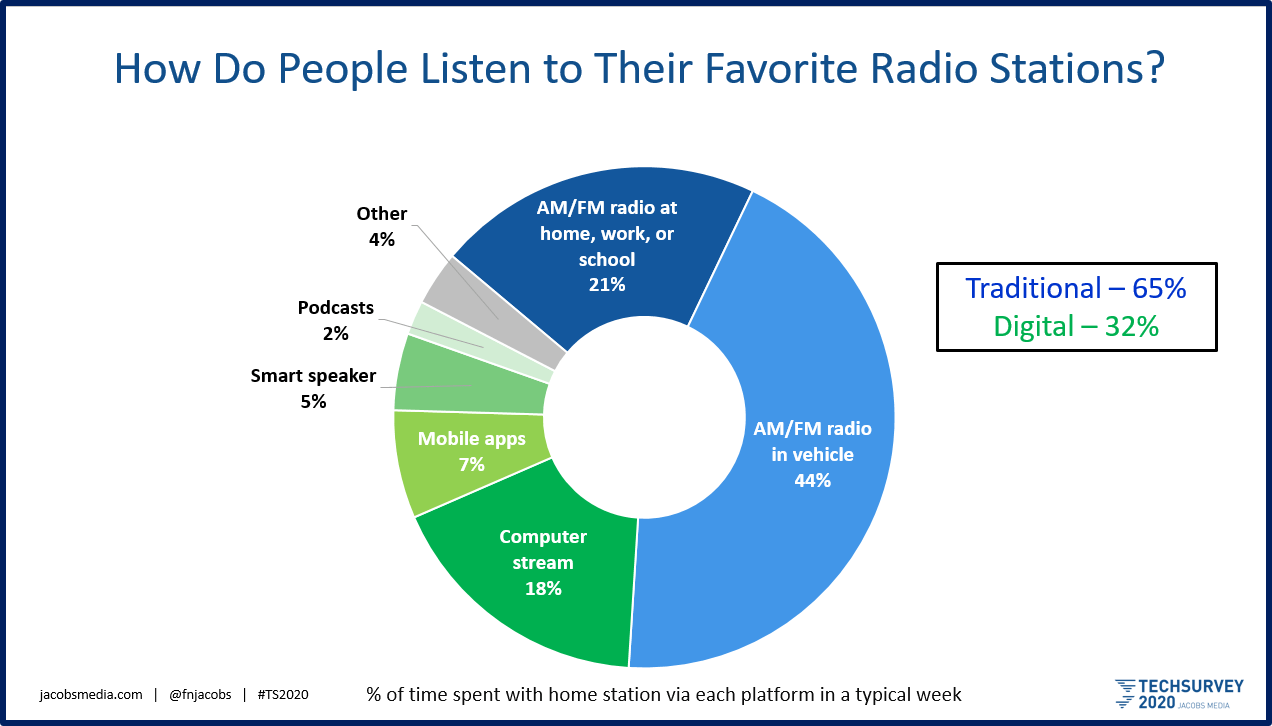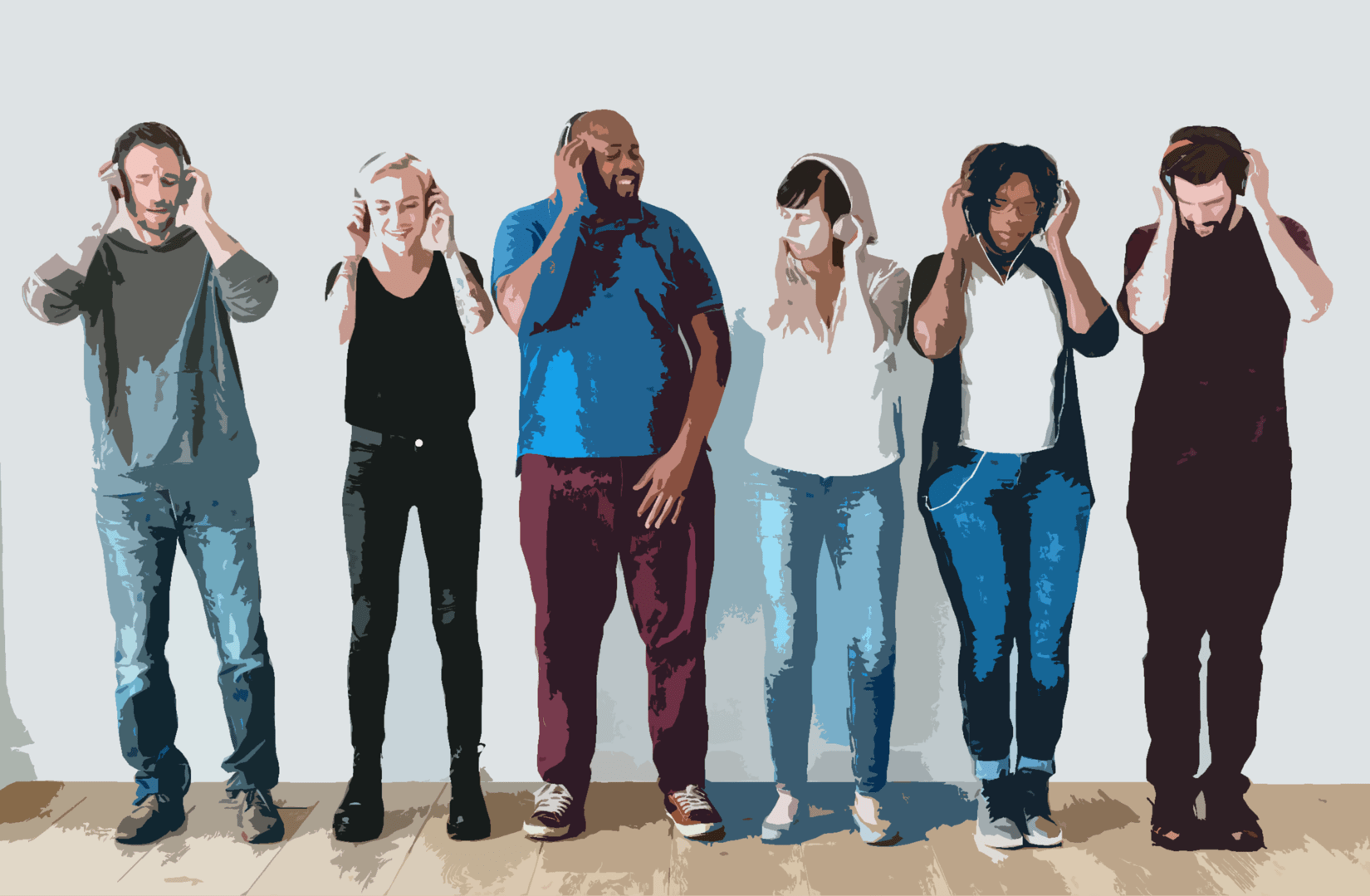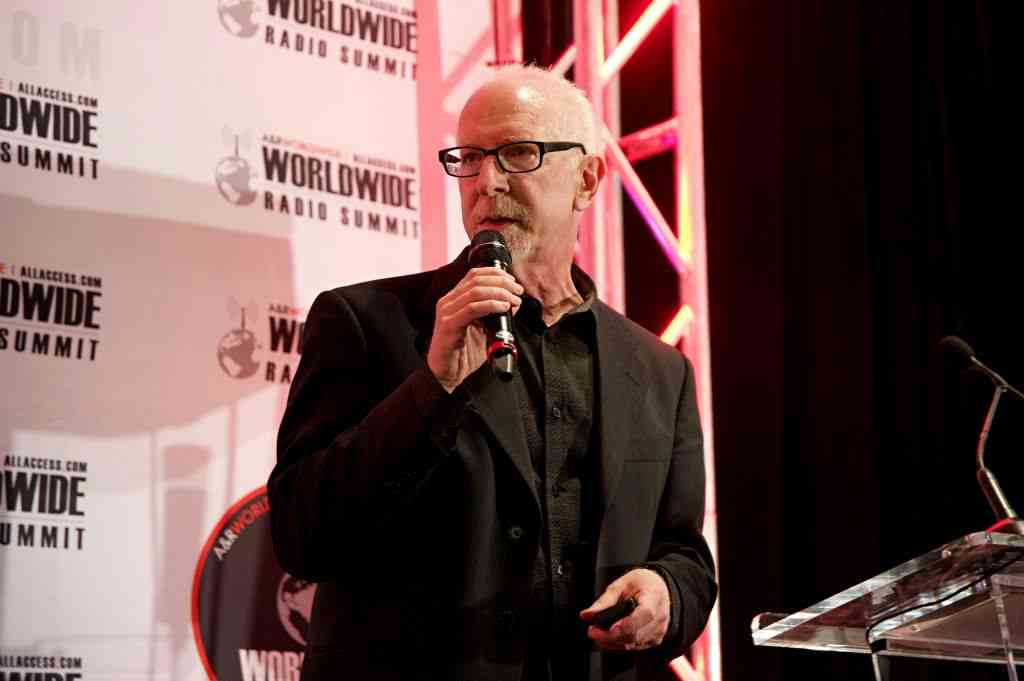
This will be a big week for us at Jacobs Media. Look for an announcement tomorrow that we are hoping will help radio more effectively battle the coronavirus crisis. But in an otherwise busy five days, we find ourselves more challenged than ever before to help make sense of it all. We know many of you are on the front lines, and we appreciate all you’re doing.
Tomorrow, I’m presenting our stakeholder webinar for the 500+ stations that participated in Techsurvey 2020. We lucked out to be sure, The interviews were all conducted in January and early February, allowing us to get this one in under the wire.
We have fresh, relevant, format-specific, and in many cases, station-specific data to share with the entire radio broadcasting industry, as well as those of you who were smart and prescient enough to take part of in the largest survey of radio listeners in the world.
On Thursday, it’s our make-good webinar for Joel Denver and AllAccess. In a different world, I’d be packing a bag tonight, and heading to LA to spend time with my friends in the radio and music industries at the WorldWide Radio Summit. Each year, I’m the pre-lunchtime “entertainment” on Thursday – presenting a fast-moving summary of key finding for hundreds of hungry (in every sense of the word) attendees.
But not this year. Along with SXSW, the NAB, Conclave, and numerous other state broadcasting association summits and conferences, none of this will happen. No cocktail parties, panels, badges, and stuffed goody bags. Not this year.
And so, I’m taking our WorldWide Radio Summit virtual. It’s not only open to those of you registered for what would have been convening at the Castaway in Burbank this week, anyone can join our webinar. (Registration info is at the end of this post or by clicking on the light blue banner below. It’s open to anyone and everyone. Already, a record number of you have signed up.)
At this time of year, I’m frequently asked by the industry trades, as well as many of you, what was the one finding that jumped out at you this year – that data point or chart that truly put things in perspective.
It’s important to remind you of the sample here. Techsurvey is very different from the data you likely saw in the Infinite Dial/Triton study presented last week. Their data is a representative sample of Americans. Ours is a sample primarily of radio listeners – people largely in the habit of listening to the radio, often members of databases or station social media followers.
And Techsurvey 2020 is made up for commercial radio listeners. (Our public and Christian surveys are slated for later this year and hopefully we will be able to produce them). So, 46,000 core commercial radio listeners in North America (yes, Canada is represented, too) – the people broadcasters need to know about. Especially right now.
So, the key finding? This year, there was a lot to choose from. Video streaming is skyrocketing – and this was happening before millions of Americans were asked to stay home and not report for work, school, or social events.
We learned a lot of radio fans would be willing to put their favorite station’s bumper sticker on their cars – if these mini-logos were made available. Maybe that’s not a breakthrough finding, but it is interesting in an industry that long stopped producing these inexpensive sticky logos.
It will come as no surprise, but “voice” continues to grow, as smart speakers proliferate. And this year, we now know where in the house these devices are located, along with more specific information about how they’re being used. Although we’re learning why the holdouts – those who refuse to bring Alexa into their homes.
We’re learning about the value of subscription services – both audio and video. And given the strong possibility of rough economic waters ahead, what may happen when consumers are forced to make tough decisions about what they’ll continue to pay for.
And we continue to garner more data about mobile apps, how they’re being utilized, and how consumers feel about radio-centric applications. Suffice it to say, those findings will be helpful as more people find themselves relying even more on their smartphones for everything.
But the biggest finding? The one that caused me to pause and consider where we’re heading as an industry, and what it means?
It turns out, it’s a few standard questions – ones that we’ve been asking for years. In presentations, I tend to show them matter-of-factly.
But not this year.
In a country where the most uttered phrases are now coronavirus, pandemic, social distancing, and “flatten the curve,” these findings are sobering for radio executives, and all of us in the industry.
When we ask respondents to think back over the previous week, and tell us on which platforms they listened to their favorite radio station, here’s the result:

The headline here – in a normal year – is the continued growth of digital listening to radio on computers, apps, and now smart speakers (the highest we’ve seen at 5% of reported weekly consumption). That’s now 32% of usage to the average station.
But the lion’s share of listening – 44% to be exact – is comprised of consumers punching up the station on a car radio.
And 21% of consumption is on “regular radios” at home, work, or school.
Add it all up, and that’s the “traditional” box on the upper right – 65% of radio usage occurring on “regular” AM/FM radios.
So, what happens now that people are stuck at home, an increasing number of which are in some form of quarantine? Infinite Dial (produced once again by Edison and Triton) tells us that roughly one-third (32%) of their sample doesn’t have a radio at home.
Our numbers are different, of course. In TS 2020, we learned that 20% of core radio listeners do not have a working radio they use where they live. Yes, that’s not as bad as Infinite Dial’s numbers but consider who our sample is made up of – radio’s most loyal, regular listeners. And one in five of them don’t have a radio where they live.
So, stepping away from the data, what do we know observationally about media usage – right here, right now? What are we seeing and hearing with our own eyes and ears?
If you’re living in or near a major city, workplaces are empty, traffic is light, gathering spots are vacant, and schools and most businesses – outside of the essentials – are closed. With people spending considerably less time commuting to work or school, radio listening is going to go down. We know this instinctively, but we can see the hard numbers in Techsurvey – for core radio listeners, the car and workplace are radio’s bread and butter.
This week, we’ll start seeing the hard evidence from those people carrying meters. Well before the COVID-19 attack, the below-the-radar conversation in radio circles has been about declining PUMM levels in Nielsen. That’s Persons Using Measured Media – and that translates to radio listening the meters capture.
 So, it seems very probable we’re about to be hit with the coronavirus “reality” of millions of people cooped up at home, out of work, and not attending schools. And it’s very likely not to be a pretty picture. Given that everyone’s models predict the virus will get worse before it gets better, we can expect Nielsen’s mirror on radio to get even uglier.
So, it seems very probable we’re about to be hit with the coronavirus “reality” of millions of people cooped up at home, out of work, and not attending schools. And it’s very likely not to be a pretty picture. Given that everyone’s models predict the virus will get worse before it gets better, we can expect Nielsen’s mirror on radio to get even uglier.
None of it will mean radio isn’t valued, that being local doesn’t matter, and that radio personalities aren’t resonating. All of this matters – a lot; perhaps even more than it did a few weeks ago. If there was a way to calculate RRPM (Radio Relevance Per Meter), the numbers would be through the roof. Programmers and air talent are getting hugs, kisses, and well wishes from many who simply took radio for granted.
But even that outpouring of love and appreciation won’t impact the sea change of listening patterns, now amplified by the reverberations of COVID-19.
What we can do is determine how the data we’re seeing in TS20 can inform our decisions moving forward – especially as radio tries to do its most important work during this existential crisis.
Usually, I’m able to pull together my Techsurvey presentations in a few hours, especially given how much longitudinal trending we are able to provide. In my presentations, you’ll frequently here me say, “Compared to last year….”
But for these webinars, I’m going to be more focused on this year’s data, and how it helps us figure out where we go from here.

For TS20. I’m looking at this data through a very different lens. And I’m going to make every effort to not just show you the results, but contextualize it for radio broadcasters tasked with their biggest challenge since the medium came into existence nearly a century ago.
Marconi, Tesla, Armstrong, and other forefathers of radio could not have imagined how game-changing this amplitude and frequency modulation technology would become. But they also could not have predicted its many challenges, adaptations, and pivots.
Over the weekend, I heard the language shift a bit from “recession” to “depression.” No matter how old you are, that’s a scary thought. The last time that occurred in America, it was FDR taking to the radio airwaves to talk straight with the worried citizenry during his famous “Fireside Chats.”
The role radio will play in this new crisis remains to be seen, of course, A lot has changed in America in nearly 90 years. But one thing that hasn’t is that most people still listen to radio.
We are in this together. So, let’s take a look at some data, do something communal again, have a laugh or two, and figure out how it can help us do our jobs and serve our communities when it’s needed the most.
The most important finding in TS2020? You tell me.
Our free webinar in partnership with AllAccess is Thursday, 3/26 at 2pm ET. Info and registration info is here.
- What To Do If Your Radio Station Goes Through A Midlife Crisis - April 25, 2025
- A 2020 Lesson?It Could All Be Gone In A Flash - April 24, 2025
- How AI Can Give Radio Personalities More…PERSONALITY - April 23, 2025




Leave a Reply